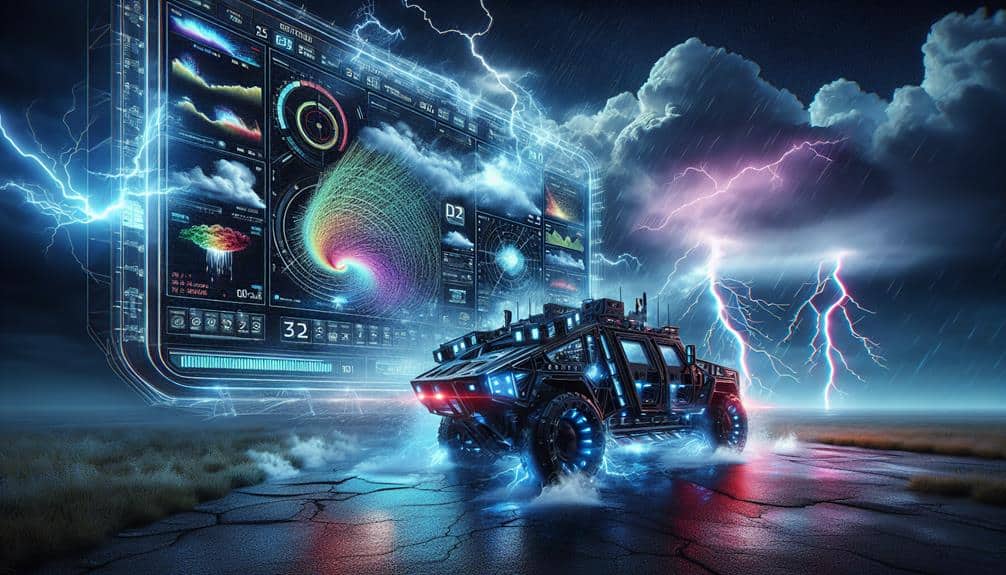We leverage advanced radar technology, high-resolution satellite imaging, and machine learning algorithms to boost storm chasing forecasting success. Real-time radar tracks mesocyclones and hook echoes with high spatial and temporal resolution, enhancing storm path predictions. High-resolution satellites provide intricate cloud pattern analysis and early detection of storm formation. Meanwhile, machine learning processes large datasets, refining predictive models and ensuring real-time updates. By integrating these methods, we can precisely anticipate severe weather events and issue timely warnings. Each method contributes uniquely to our predictive capabilities, offering a detailed view into the dynamic nature of storm systems.
Key Points
- Advanced radar technology provides real-time tracking and enhanced accuracy in forecasting storm paths.
- High-resolution satellite imaging offers detailed views and precise tracking of storm systems.
- Machine learning algorithms enhance data processing and improve predictive modeling for storm forecasts.
- Real-time updates from machine learning algorithms ensure forecasts are always current.
Advanced Radar Technology
Advanced radar technology has transformed storm chaser forecasting by offering real-time, high-definition data that enhances our ability to forecast severe weather events accurately. With advanced Doppler radar systems, we can now use real-time tracking to monitor storm development, intensity, and movement with unmatched precision. This technology allows us to dissect storm structures, identifying key features such as mesocyclones and hook echoes that indicate potential tornado formation.
By integrating real-time radar data with sophisticated predictive analysis models, we're able to forecast storm paths and potential impact zones with greater accuracy. The radar's capability to measure wind velocities at various altitudes facilitates the identification of wind shear, a key element in severe storm formation. As a result, we can issue timely warnings and deploy resources more efficiently.
Furthermore, radar's high spatial and temporal resolution means we can track rapid changes in storm dynamics, providing valuable minutes of lead time that are essential for safety and preparedness. This capacity for detailed, immediate observation empowers us to make informed decisions, ensuring that we remain flexible and responsive in the face of fast-evolving weather conditions.
Advanced radar technology is vital in our pursuit of storm chasing success and the freedom it brings.
High-Resolution Satellite Imaging
High-resolution satellite imaging provides us with detailed views of storm systems, allowing for precise tracking and analysis of weather patterns from a macro perspective. By leveraging this technology, we can identify intricate cloud patterns that signal the development and progression of severe weather events. This capability enhances our weather prediction accuracy, enabling timely and informed decision-making.
Utilizing high-resolution satellite data, we can monitor atmospheric variables such as temperature, humidity, and wind speed with exceptional precision. These parameters are important for understanding storm dynamics and forecasting potential paths. The satellite imagery allows us to detect early signs of storm formation, such as convective cloud structures, which are often precursors to severe weather.
Moreover, the spatial resolution of these images is a game-changer. It allows us to zoom into specific areas and analyze localized weather phenomena, providing a thorough overview that ground-based radar systems might miss. We can track the evolution of cloud patterns minute-by-minute, offering real-time insights that are essential for storm chasing and safety.
Machine Learning Algorithms
Building on the detailed insights from high-resolution satellite imaging, machine learning algorithms enable us to process and analyze vast amounts of meteorological data with unprecedented speed and accuracy. These advanced tools enhance our data analysis capabilities, allowing us to generate precise predictive modeling that can forecast storm patterns with remarkable reliability.
By leveraging machine learning, we can identify critical weather variables and their interactions, providing us with a deeper understanding of storm dynamics.
Consider the following advantages that evoke a sense of empowerment:
- Enhanced Data Processing: Machine learning algorithms can handle enormous datasets, parsing through information faster than any manual method.
- Improved Predictive Modeling: These algorithms refine our predictive models, increasing the accuracy of storm forecasts and minimizing uncertainty.
- Real-Time Updates: Continuous data analysis and model adjustments make certain that our forecasts are always up-to-date, offering real-time insights.
- Resource Efficiency: Automation in data processing and predictive modeling frees us from labor-intensive tasks, allowing us to focus on strategic decision-making.
Our goal is to harness the power of these technologies to achieve a higher level of forecasting precision. This not only aids in effective storm chasing but also empowers us with the freedom to make informed, timely decisions.
Frequently Asked Questions
How Do Storm Chasers Stay Safe During Severe Weather Events?
98% of storm chasers follow strict safety precautions. We use advanced technology and clear communication strategies to guarantee our emergency plans are effective. Staying informed and connected helps us maintain our freedom while staying safe.
What Are the Essential Tools and Equipment for Storm Chasers?
We rely on technology advancements like radar systems, GPS, and communication devices. Safety measures include lightning detectors, first-aid kits, and protective gear. These tools guarantee precision, safety, and autonomy while maneuvering through severe weather events.
How Do Storm Chasers Communicate in Remote Areas?
We use satellite communication and drone surveillance to stay connected in remote areas. Satellite phones provide reliable contact, while drones gather real-time data, ensuring we make informed decisions and maintain our independence in challenging environments.
What Role Does Social Media Play in Storm Chasing?
Ever wondered about the real power of social media? We leverage its impact for real-time updates, boosting community engagement and public awareness. It's a game-changer, enhancing our storm-chasing precision and keeping everyone informed and safe.
How Do Storm Chasers Collaborate With Meteorologists and Emergency Services?
We employ collaboration strategies with meteorologists and emergency services by using advanced data sharing. Storm chasers contribute real-time data, enhancing forecasting techniques and improving public safety. Our teamwork guarantees precise, timely responses to severe weather events.


